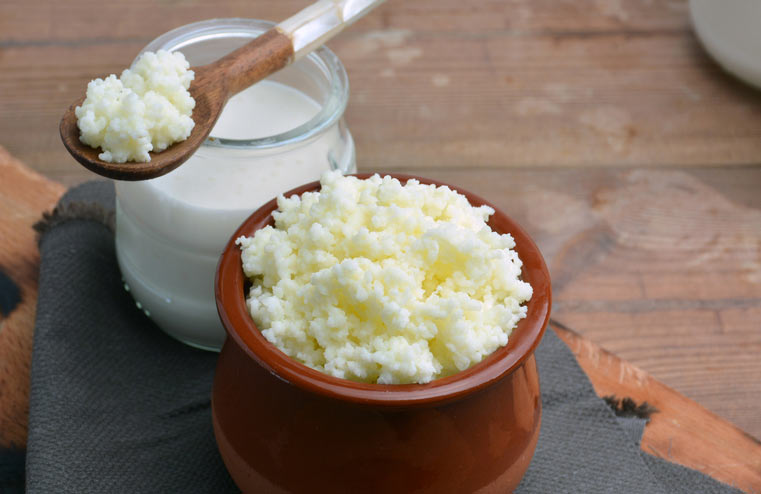Buy Organic Live Milk kefir Grains Online in India

Buy Organic Live Milk Kefir Grains online
Buy Pure , Organic and 100% live Milk kefir Grains at best prices at your doorsteps . Make fresh Milk kefir at home and make your family healthy .
MAKING MILK KEFIR
- Obtain grains online . You can do so by clicking on buy now button above .
- Place about 1 tablespoons of grains into a jar.
- Pour in your chosen milk(cow , buffalo goat, sheep ). Fill to about the 3 cup mark.
- Place the lid on, or cover with a cloth and a rubber band.
- Let your jar sit at room temperature away from direct sunlight for 24 hours (see “Fermentation Time” below for more detail).
- Strain finished kefir into a jar through a nonmetallic, fine-mesh strainer.
- Place grains into a new jar or vessel and cover in milk.
- Repeat.
The essential elements for successful milk kefir fermentation:
- Temperature – Room temperature is great for milk kefir. We have found that anything in the 64 to 78 degree F (17.7-25.5 C) range will work just fine. In our experience, a broad range of “room” temperatures work well for kefir, but major changes in temperature will impact the speed at which your kefir ferments. When the seasons change, your kefir will most likely need a little adjustment time. Warmer temperatures will speed up fermentation, lower temperatures will slow it. In periods of seasonal change, kefir is sometimes thin in consistency or very yeasty smelling. Its not to be taken as botheration too much, as they always come out fine after a week or two of adjustment.
- Aerobic or Anaerobic? – There are different kinds of fermentation. Some require air, others require no air. Milk kefir is technically an anaerobic process, but you don’t need to work to keep your grains submerged like you do when pickling vegetables. The milk itself seems to be a sufficient barrier to air, and many of your grains will stay at the bottom of your vessel during fermentation.
- Fermentation Time – There is definitely some subjectivity here, although you do want to care for your grains by giving them a somewhat balanced living environment. The longer they ferment the more acidic your kefir will be and the lower it will be in lactose. We don’t recommend fermenting for longer than 48 hours. Although these grains are acid tolerant, even they have their limits. If you like a lower lactose product, I recommend continuing fermentation (secondary fermentation) after removing the grains. If you want to experiment with longer fermentation times, you can always wait until your grains grow enough to split and then use your spare set for experimentation. Our preferred time is 24 hours during stable periods. When the weather gets very cold, they usually need at least 36 hours. When the weather gets very hot, they are occasionally done in 12 hours.
MILK CHOICE
You can make milk kefir from just about any kind of milk, but please read below exceptions and details. Just remember to give your grains a period of adjustment when you switch from one milk to another. Buy organic live milk kefir grains online in India from us as we sell the highest quality kefir grains available in india so far .
- Fat content – Every set of grains I’ve had has been happiest in full-fat milk. The texture and consistency are more to my liking and the grains seem to ferment and reproduce more readily in full-fat milk than in lower-fat milks. However, lower-fat milks are totally fine to use if that’s what you and your family prefer. Your grains may reproduce more slowly, and your final product may not be as delicious, but that’s okay (and also subjective!)
- Raw vs. Pasteurized – Some grains that you purchase will come with a note or a warning that raw milk can kill them. Raw milk has a very heavy bacterial load that can sometimes compete with or dominate the colonies in your grains.When you get new grains, we recommend growing them in the same type of milk that they have been grown in by their previous owner, at least for a while. If they’re used to pasteurized and you want to use raw, give them a couple weeks in their original milk, then split the grains. Run them through the normal kefir paces for a couple weeks and see how they’re doing, and continue to maintain a batch in the pasteurized milk, just in case. After several batches, take note: Have your grains shrunk or grown (weighing them before you start is a good way to measure this? Is the kefir you’re getting ideal in flavor taste and texture? If they seem to be thriving after several batches, you are good to go.
- Animal – Goat milk kefir is delicious.Sheep, Boffalo and Cow’s milk works great too. So be open and make your deleicious kefir at home .
- Non-Dairy – Non-dairy milks do not contain lactose . You can do the tricky, dual-culture method, in which you switch your grains back to dairy milk every 4-5 days, but most people find that too difficult to maintain. If you are vegan or cannot have any dairy at all, we would recommend trying a different cultured beverage, such as water kefir . If you dislike dairy or can only tolerate small amounts, you can use a very small amount of finished milk kefir to culture your non-dairy milks. Using 1 T of finished kefir to 1 quart of alternative milk usually does the trick. It’s not perfect, but it’s an option.


